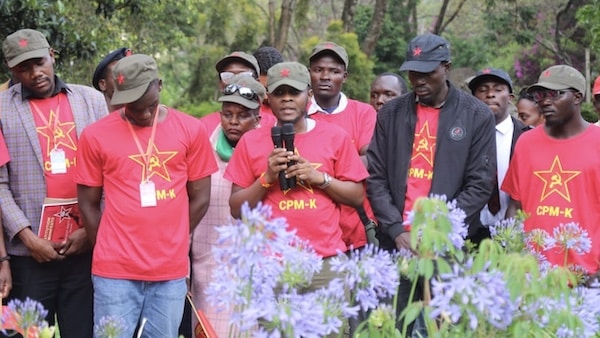The Communist Party of Kenya (CPK) held its 2nd National Congress on November 16–17, 2024, marking an important chapter in its long struggle for socialism. Under the theme “Advancing the National Democratic Revolution for a Truly Independent Socialist Kenya,” the congress solidified its ideological foundation, restructured its organization, and formalized a significant realignment.
A New Identity: Communist Party Marxist Kenya (CPM-K)
In a historic move, the congress adopted a new name and ratified the reconstitution of the Party as the Communist Party Marxist Kenya (CPM-K) with new leadership to lead the party with a renewed focus in deepening the party ideas to the masses.
Alongside the new name, the party also unveiled new symbols: the Party’s emblem—a red star, hammer, and sickle in gold—introduced as a unifying symbol of the revolutionary struggle. “This symbol reflects our enrichment, not just in natural resources like minerals, but also in ideological richness,” said Secretary General Booker during the unveiling.
In its first day, the congress reaffirmed CPM-K’s ideological stance that Kenya remains a capitalist society where the ruling elite serves imperialist interests at the expense of the working masses. Delegates unanimously endorsed the continuation of the National Democratic Revolution, asserting that socialism is the only path to achieving true independence and self-determination for Kenya and Africa at large.
The congress was a grassroots-driven affair, with 126 accredited delegates from all 47 counties of the country attending. Their diverse representation highlights the Party’s strong connection to Kenya’s working class and peasantry. Additionally, 54 representatives from international communist and workers’ organizations graced the event, emphasizing the CPM-K’s role within the global socialist movement. Messages of solidarity poured in from international socialist organizations, including the Communist Party of China, the South African Communist Party, the Communist Party of the Philippines, the Communist Party of Great Britain (Marxist-Leninist), the Communist Party of India (Marxist), the All-African People’s Revolutionary Party (AAPRP), the Party for Socialism and Liberation (PSL), Pan African Today, and the National Union of Metalworkers of South Africa (NUMSA). These messages expressed shared commitment to the struggle against imperialism and global capitalism.
As highlighted in the AAPRP’ statement:
We share the common objective of Revolutionary Pan-Africanism—the total liberation and unification of Africa under scientific socialism. At this historical moment, when true liberation has yet to be attained and socialism remains a distant reward to be pursued after victory, unity stands as the cornerstone of the contemporary struggle for Pan-Africanism. We must unite to defeat imperialism and achieve our liberation.
‘MAU MAU, MALCOLM X INSPIRE US TODAY’ – EUGENE PURYEAR
The spirit of Mau Mau, Kenya’s fearless anti-colonial Land and Freedom Army (1952-60) that spearheaded the country’s struggle for independence from British rule, was rekindled at the recently concluded the Communist Party… pic.twitter.com/2e2lJQg8sj
— African Stream (@african_stream) November 20, 2024
The congress also focused on strengthening the Party’s mass-line strategy and structures, which prioritizes grassroots mobilization and the active participation of ordinary Kenyans in the fight for socialism. Among the revitalized structures were the Women’s League and the Young Communist League (now Revolutionary Youth League) —both key pillars in building a mass-based revolutionary movement.
The Revolutionary Student Commission (RSC) was reconstituted to organize students and connect their struggles with broader societal challenges, such as unemployment, rising costs of education, and systemic inequality. The grouping also aims to foster a new generation of ideologically grounded cadres.
The party addressed the key questions of the Kenyan National Democratic Revolution, as well as the issues of alliances and coalitions. They adopted the Pan-African Socialist Alliance Charter (PASA) and clarified their participation in the National Coordinating Committee of the People’s Assemblies (NCCPA).
PASA is a grouping of anti-imperialist and anti-capitalist organizations in Kenya, rooted in the principles of Revolutionary Pan-Africanism, Feminism, International Solidarity, and Scientific Socialism. NCCPA is a coalition of progressive organizations and revolutionary parties, including CPM-K. It is built on the foundation of People’s Assemblies, which play a critical role in uniting the proletariat and peasantry—those who endure the harshest exploitation under the semi-colonial state.
During the Congress, Dedan Kimathi was unveiled as a symbol of Kenya’s National Democratic Revolution, representing the enduring struggle for independence and resistance against colonial oppression. To honor his legacy, party cadres and delegates held a procession to the Kimathi statue along Kimathi Avenue.
Another highlight of the congress was the launch of the Pio Gama Pinto Ideological School, named after the anti-imperialist martyr who dedicated his life to Kenya’s liberation struggle. The school is set to deepen revolutionary discipline and ideological unity among CPM-K cadres, equipping them with the ideological tools to lead the struggle for socialism in Kenya.
Delegates paid homage to Pinto by visiting his grave at City Park. This revolutionary moment was followed by a vibrant cultural event in Githurai—a “Reggae for Socialism” session where Party members and delegates connected with the masses and renewed the importance of art in the revolutionary struggle.
The Congress concluded with a renewed commitment to advancing socialism in Kenya. With grassroots mobilization at its core, the CPM-K Congress pledged to intensify the fight against exploitation and imperialism.
On November 22, just a week after the congress, Mwaivu Wa Kaluka, the National Chairperson of CPM-K, and Kinuthia Ndungu were arrested and detained at Central Police Station in Nairobi. Their arrests follow a sharp uptick in repressive actions against the party following the #RutoMustGo mobilizations.
Alert! 🚨 National Chairperson Cde Mwaivu Kaluka (@MwaivuWaKaluka) and Cde Kinuthia Ndung’u, the Organizing Secretary (@SankaraKinuthia), have been arrested in town and are being taken to Central Police Station. No reason has been given for their arrest. Stop this abduction now! pic.twitter.com/68j3QOhUXL
— Communist Party Marxist CPM – Kenya (@CommunistsKe) November 21, 2024
Nicholas Mwangi is a member of the Ukombozi Library in Kenya.

